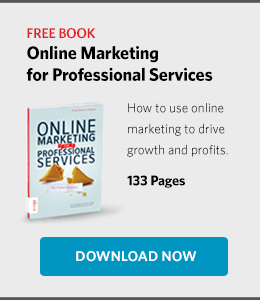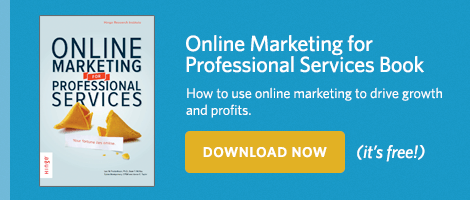Retargeting. You’ve might have seen this term a lot lately in the online paid advertising world. But what is it? And how does it work?
When you build a website for a professional service firm, most of the time the goal is the convert visitors into leads. A general rule of thumb is that only about 2% of users convert on the first visit to a new website.
With retargeting, you can advertise your brand to website visitors long after they have left your site (the other 98%), with the intention of getting them to return to your site and eventually turning them into a lead.
Who can be reached with retargeting?
- Website visitors
- Users who have not visited your website, but are searching online using relevant keywords that you want to be found for
- Social media audiences
- Contacts in your marketing automation and/or customer relationship management (CRM) systems

SEE ALSO: Developing a Data-Driven Marketing & Sales Strategy with Marketing Automation
There are many different types of retargeted ads. Using your Google Analytics, you can determine which may be the best option for your firm. Look at how people are coming to your website. Is it through your email campaigns? Through organic search or social media?
This will help you determine which approach will give you the most impact and where to focus your retargeting efforts.
What are the types of retargeting?
There are a number of retargeting options — and they can quickly get overwhelming. Here’s a rundown of the major types of retargeting that your professional services firm might want to consider.
1. Pixel-based:
These ads for your firm will show up on other sites after a visitor has left your site. This works by placing a piece of code on your website. The code will drop a cookie when you have a new visitor to your website. That cookie will allow for your retargeted ads to be served up to those individuals once they leave.
2. Search retargeting:
Search retargeting serves ads to individuals that haven’t yet visited your firm’s website but are using certain keywords or keyword phrases that are related to your firm, its services, or the challenges that you help solve.
3. SEM/SEO retargeting:
This is a more complex form of retargeting that uses the search terms and actions taken when the visitor lands on your site. You can target ads based on keywords and/or tags from your site.
4. List-based:
Target ads to your existing contacts. Upload your list to a platform (such as Facebook or Twitter) and ads will appear to those people on your list.
5. Email retargeting:
This option targets people from your email campaigns and the actions they took within an email. For example, you can have a certain ad for those who opened an email, those who clicked through to your website from the email, those who didn’t open email, and those who shared the email on social media.
6. Social retargeting:
This type of retargeting tracks users on social media and how they consume content (such as what they read and share) and serves them ads accordingly.
7. Contextual or partner retargeting:
Using the pixel method listed above, contextual or partner retargeting exchanges pixels between websites that are highly relevant to the searcher and target to each other's visitors.
The Major Benefits of Retargeting
There are a number of benefits to retargeting ads to your visitors and existing contacts.
- Having a targeted audience who is already familiar with your website in some form will increase your effectiveness.
- It keeps your brand in front of the prospective clients and top of mind.
- It builds brand awareness through repeated exposure.
- It has the ability to target by where prospects is in the sales funnel, such as having an awareness campaign for new visitors, and conversion offers for those later in the funnel.
- It has the ability to advertise services based on how engaged user is.
- It helps remind users of the reasons they engaged with you to begin with, which can trigger more actionable steps.
Taking the benefits into consideration, how can you make the most of your retargeted ads?
Retargeting Best Practices
- Your ads should have a clear call to action (CTA). When visitors reach your ad’s landing page, they should know exactly what step you’d like them to take. This might include subscribing to a blog or newsletter, downloading a piece of content, registering for an event, or signing up for a free consultation.
- Ideally, an ad should appear in front of a user 7 to 12 times during a 30-day period to get maximum engagement.
- But don’t bombard a user with ads for your brand if they’ve only visited your website once or twice. Use a frequency cap to put a maximum on the number of ads a user will see for you.
- Segment your audience as much as is feasible. Make different offers for people who visit different pages. If they visit your homepage, general branding and awareness may be the best approach. If they visit a content download page, offer the content download in an ad.
- Use A/B testing to see which ads work. You can test things like colors, CTAs, copy and more. This way you will optimize your advertising efforts.
Retargeting can be a strong supplemental marketing technique to reach your target audience. Users you’ve already engaged with, or users who have already engaged with your firm by visiting your website, can be reminded of your brand and your services.
Even individuals who aren’t aware of your firm and are just searching for the services you offer can be targeted. Done correctly, you can reach the right audience to get them into and keep them moving through your sales funnel and help convert them into an opportunity and new business.
Additional Resources
- Download a free copy of Hinge’s book Spiraling Up to learn how to create a high-growth, high-visibility firm.
- Learn about the most effective online marketing strategies in the book Online Marketing for Professional Services.
- Join us on LinkedIn and Twitter for more marketing tips and strategies.
How Hinge Can Help
The Visible Firm℠ is the leading marketing program for delivering greater visibility, growth, and profits. This customized program will identify the most practical offline and online marketing tools your firm will need to gain new clients and reach new heights.

